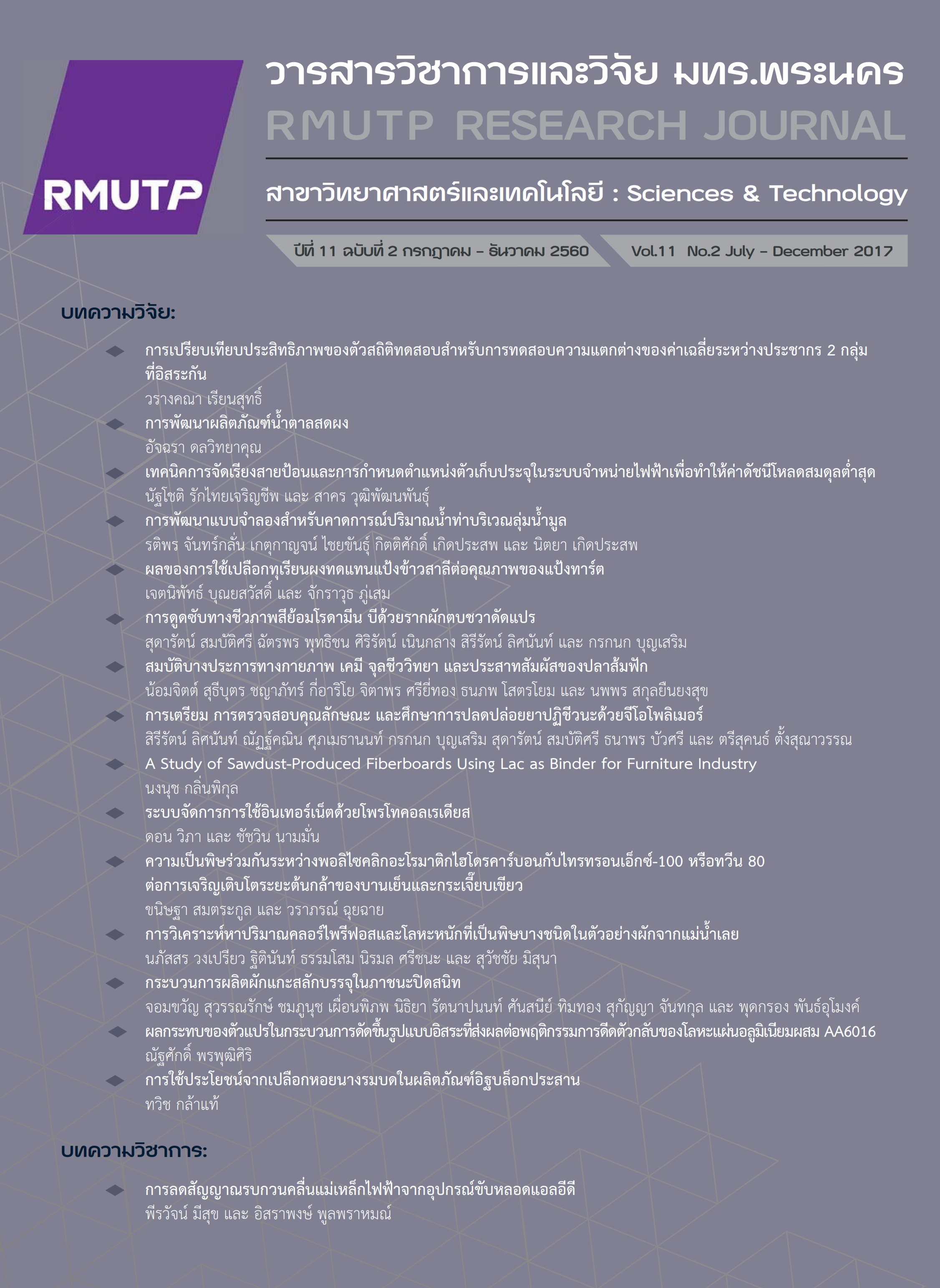กระบวนการผลิตผักแกะสลักบรรจุในภาชนะปิดสนิท
Main Article Content
Abstract
การศึกษาหากระบวนการผลิตผักแกะสลักบรรจุในภาชนะปิดสนิทสำหรับผัก 5 ชนิด ได้แก่ แครอท ฟักทอง หัวไชเท้า มะละกอดิบ และแตงร้าน ที่แกะสลักเป็นดอกกุหลาบหรือใบไม้ดองในตำรับน้ำดองปรับกรด (น้ำส้มสายชู 7.23% น้ำ 64.81% เกลือ 0.81% น้ำตาลทราย 27.00% และกรดแล็กทิก 0.15%, pH 3.27) โดยนำแครอท ฟักทอง และมะละกอดิบแกะสลักไปฆ่าเชื้อในสารละลายกรดเพอร์ออกซีแอซีติกแอซิด (80 mg/L, 3 นาที) ส่วนหัวไชเท้าและแตงร้านแกะสลักจุ่มในน้ำประปา (3 นาที) ลวกในสารละลายเกลือแคลเซียมคลอไรด์ (0.5%, 2 นาที) ดองในกล่องพลาสติกมีฝาปิดสนิท และเก็บรักษาที่อุณหภูมิห้อง (25ºC) เป็นเวลา 4 วัน พบว่า พีเอชและบริกซ์มีค่าลดลงตลอด 4 วัน และมีแนวโน้มเข้าสู่สมดุล มะละกอดิบและแตงร้านเกิดการเน่าเสียในวันที่ 4 โดยเกิดฟองแก๊สและฝ้าสีขาวบนผิวน้ำดอง ดังนั้นจึงนำแครอท และฟักทอง มาดองในตำรับน้ำดองที่เติมสารกันเสีย (น้ำส้มสายชู 27.03% น้ำ 27.03% เกลือ 0.9% น้ำตาลทราย 45.05% และโซเดียมเมแทไบซัลไฟต์ 200 ppm, pH 3.39) แล้วนำไปบรรจุร้อนในขวดแก้วมีฝาปิดสนิทและเก็บรักษาที่อุณหภูมิห้อง พบว่า ผักแกะสลักดองทั้งสองชนิดมีระยะเวลาในการเข้าสู่สมดุล 7 วัน โดยค่า
พีเอชจากตัวอย่างน้ำดอง น้ำดองผสมเนื้อ และเนื้อผักแกะสลักมีค่าต่ำกว่า 4.6 และบริกซ์ลดลงเรื่อยๆ อายุการเก็บรักษาของแครอท ฟักทอง และหัวไชเท้าแกะสลักดองในขวดแก้วมีฝาปิดสนิทไม่น้อยกว่า 7 วัน โดยมีจำนวนจุลินทรีย์ทั้งหมด ยีสต์รา และ Escherichia coli ไม่เกินเกณฑ์มาตรฐานของกระทรวงสาธารณสุข และตรวจไม่พบ Staphylococcus aureus
Vegetable-carved processing in hermetically sealed container
The study of vegetable-carved processing packed in hermetically sealed container for 5 types of plant e.g., carrot, pumpkin, radish, green papaya and cucumber which carved into rose or leave shape and preserved in acidified-pickle (7.23% vinegar, 64.81% water, 0.81% salt, 27.00% sugar and 0.15% lactic acid, pH 3.27). The processing were conducted by sanitized carved-carrot, pumpkin and radish in peroxyacetic acid solution (80 mg/L, 3 min), or dipped in tap water (3 min) for green papaya and cucumber. Then, all carved-vegetables were blanched in calcium chloride solution (0.5%, 3 min) followed by preserved in acidified-pickle in plastic box with a lid and stored for 4 days at room temperature (25ºC). The results showed that pH and °Brix decreased during 4 days storage, and showed obviously tended to equilibrium. However, carved-radish and cucumber were spoiled by microorganisms as a film on the surface of pickle solution, and gas bubble was occurred inside a container on 4th days of the storage. Hence, carrot and pumpkin, were used in the next experiment which preserved in preservative-added recipe (27.03% vinegar, 27.03% water, 0.9% salt, 45.05% sugar and 200 ppm sodium metabisulfite, pH 3.39) with hot-filled method in glass bottle. The pH of samples of pickle solution, carved-vegetables and mixed-sample, showed lower than 4.6, and °Brix were gradually decreased during storage periods. Shelf-life of carved-carrot, -pumpkin and -radish stored in hermetically sealed container was up to 7 days. Total bacteria count, Escherichia coli, yeast-molds were not exceeded than the standard limited by Ministry of Public Health and Staphylococcus aureus was not detected.

